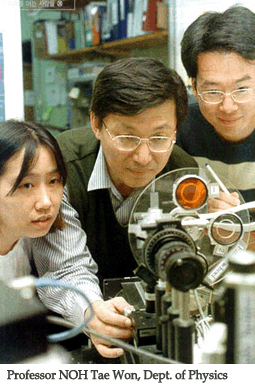 The study of insulator-metal transitions (IMT) in transition metal oxides, where conductivity changes from an insulator to a metal, is important for understanding phenomena such as superconductivity.
The study of insulator-metal transitions (IMT) in transition metal oxides, where conductivity changes from an insulator to a metal, is important for understanding phenomena such as superconductivity. For the first time, Professor NOH Tae Won at Dept. of Physics has controlled IMT in a series of 5d transition metals compounds, where a successively decreasing bandwidth of their electronic states leads to insulating behavior.
The electron bonds in transition metal oxides have a strong polar component, which leads to strong electrostatic interactions between the electrons of their outer orbitals. This repulsion results in a gap in the electronic states, so that these otherwise metallic materials become insulating. Most of the oxide compounds based on transition metals from the third or fourth period of the periodic table are insulators. Those from the fifth period were predicted to behave like metals, as the interaction between the spatially extended 5d orbitals is too weak.
However, recently was it realized that some 5d transition metal oxides could exhibit insulating behavior due to strong spin-orbit coupling. Owing to their natural scarcity “the 5d transition metal oxides are an unexplored territory, rich in novel physical phenomena that often deviate from conventional expectations,” says Professor Noh.
Two examples are Sr2IrO4 and Sr3Ir2O7 (Fig. 1), which are members of the 5d series Srn+1IrnO3n+1. Compared to Sr2IrO4 (n=1), Sr3Ir2O7 (n=2) has more adjacent Ir atoms, which leads to an increased electronic bandwidth of the 5d orbitals and thus to a reduced band gap.
The researchers now extended this series to SrIrO3 (n=infinity). As the bulk form of SrIrO3 does not crystallize in the right structure, the researchers studied thin films, as the deposition process allows the fabrication of metastable phases that would not form otherwise. As expected, these SrIrO3 films were found to be metallic, as the further increased bandwidth of the 5d orbitals fully closes the band gap.
“We will continue to pursue to synthesize 5d compounds that do not exist in nature, to systematically study their electronic properties and to discover their unusual and interesting physical properties,” says Noh.
June 9, 2009

